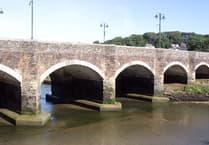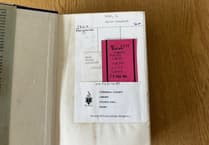Emotional residents have spoken of their fears that decades of locals enjoying nature and open fields near Truro city centre will come to an abrupt end when over 270 homes are built. A councillor choked back tears as she said the felling of trees to make way for a huge Wain Homes development was the “saddest thing I’ve ever seen”.
Last month Cornwall Council approved 274 homes at Dudman Farm in the Newbridge area of Truro, which has been on the cards for around ten years. The final approval comes with fewer affordable homes and less public open space than originally submitted. There were 125 public objections and none in support of the plans which have been approved with 18 conditions.
The site – behind the busy Highertown area of Truro – comprises two main development areas. Dudman West will provide 75 homes and Dudman East will see 199 properties. Work has already started and fields cleared much to the anger and sadness of neighbouring residents.
They say people living in this part of the city have had informal access across the land for decades, with generations of children playing in the valley and dog walkers using the fields for exercise. They are particularly concerned that they may no longer be able to access a field which is earmarked for “biodiversity net gain”; a move they say is pointless as the field is already a haven for flora and fauna.
However, Wain Homes has argued there will now be public open space for people living nearby as currently there isn’t any official public access permitted.

Karen La Borde, Green Party councillor for the Malabar ward at Truro City Council, lives near the development site. She choked back tears as she talked to me on the fields which will eventually be full of houses, with the remnants of felled trees visible around her.
“This is the saddest thing I have ever seen,” said Cllr La Borde. “Dudman Farm, unfarmed for 20 years, is a wildness of sessile oaks, long grasses, cow parsleys and nature’s seasonal colours. Dudman rolls either side of a wooded valley and sits alongside our play park. It’s dog walking country.
“Dudman has been this way for as long as I have known it, until a man from Guernsey bought the farm for twelve million pounds, made a planning application and the oaks are sentenced – not tall enough to be considered trees. Short in stature, they are nothing more than scrub to be felled.”
Cllr La Borde said she and her neighbours were haunted by “the sound of motor, saw and shredders echoing along the valley through the play park”.
She said locals have two major concerns, the main one being will the public retain informal access over these fields. Concerning the other, she said: “The area designated for ecological mitigation has rewilded over 30 years. It is stunning. Wildlife abounds and the group is concerned that for biodiversity net gain purposes, the developer will use this land to gain credits for planting wildflower meadows and trees in an area which has already achieved ecological stability and biodiversity richness.”
There are also concerns about badger setts in the area and run-off from the sloping site into the valley below. We have met and talked to a number of residents in the Newbridge area who are worried about the latest housing development in the city.

Derek Green, chairman of Kenwyn Parish Council, said he was concerned that what was originally presented ten years ago in outline planning form has changed significantly in its finished format. He also feared that the amount of new houses and cars will have a huge impact on Newbridge Lane, which many other residents feel isn’t sufficient to cope with growing traffic.
Helen Perkins, who lives near the site, said there are already near-misses at a roundabout near the road’s Spar shop, leading from the busy A390. “Having lots more cars could lead to someone being killed,” she said.
Ryan Fern, manager of Tennis for Truro, runs the city’s tennis club below Newbridge Park, which abuts the Dudman Farm site. He told us: “We are very worried about drainage issues as we’ve noticed a massive increase in water running down since the development across the road was developed and we are constantly flooded in the club, so it will be so much worse once they put new houses and less trees.
“It is such a sad sight walking into the fields now with all the mature oak trees cut down as well as the damage to the nature and lack of green spaces, not to mention access as the shop roundabout is already very difficult to navigate at the best of times.”
Hendrika Metcalfe added: “I do not understand where the demand for these houses is coming from. I live in Truro and within two minutes from my front door there are three properties with ‘to let’ signs outside, which have been up for at least six months. My neighbour has been trying to sell her property for over a year and has now decided to rent it instead. If you drive around Truro there are numerous ‘for sale/to let’ boards on display. Is another development really needed? Also, the Langarth Garden Village [which is being built further along the A390] will have thousands of houses.
“This destruction of the green belt surrounding Truro is truly worrying. I used to be able to hear owls at night in central Truro. I don’t hear them anymore.”
Local resident Gill Hanfrey said: “I have spoken to many other dog walkers since the building work took place and many have been horrified by the destruction that has taken place and were also deeply saddened.
“I believe they are putting up nearly 300 houses which is far too many … the road is already very busy as you pull out from Newbridge Lane by the Spar and this will also make it worse. This is the wrong site for this development sadly, but what can be done now?”
Sue Graham summed up her neighbours’ concerns about the possible loss of nature in the vicinity. “I have been walking my dogs around the fields at Dudman Farm for 15 years. It really has been a taste of countryside on the doorstep. I am often there at sunrise and have enjoyed seeing deer, rabbits, foxes, badgers, the sound of birdsong, dew in the autumn cobwebs; blackberry picking, the trees, and wild flowers.
“It’s been a real joy walking around uncultivated countryside. With the loss of this, we have been left with a ‘green gym” – a boring path around a small field, with an over-population of dogs and people walking round and round. There’s not enough green space and wildlife for the level of nearby housing. There are more parks and open spaces in most other cities than here now.”
A spokesperson for developer Wain Homes has responded to the residents’ concerns. He said: “The development will contain areas of land that will formally become public open space, whereas currently no official access is permitted. We are also providing areas of open space in excess of what the council would normally require.
“Once the development is finished there will, in fact, be more open space and areas for wildlife than built form. Nearly 30 per cent of the whole site area will be open to the public to enjoy. In addition, there will be 10.7 hectares of protected areas set aside to allow the ecology to thrive.”
He added: “We have worked closely with the council’s ecologist in the formation of the development plans and have delivered an increase in the levels of biodiversity net gain above base levels (before development). We have undertaken extensive relocation of any impacted species, under the watch of independent and qualified ecologists before any soil on site was disturbed. Furthermore, all the necessary licences have been obtained from bodies such as Natural England before any works took place. Areas designated for ecological land will be left to ensure that habitats are protected and any work to these areas will only be to increase the quality of habitats which will be in strict accordance in line with advice received from Cornwall Council’s ecologists.
“We are required to relocate the trees of high importance, such as the Plymouth Pear, as well as undertake substantial levels of tree planting to compensate for any loss. This was agreed in consultation with the council’s own tree officers. The development will deliver levels of tree cover onsite that is in excess of requirements identified with Cornwall Council policies.”
He also tackled the locals’ concerns about run-off from the site and road safety. “We have worked closely with the Lead Local Flood Authority (LLFA) to produce drainage designs which have a level of safety built in to take into account any potential future extreme weather events and any potential impacts of climate change. All designs will be signed off by the LLFA to ensure they are suitable.
“Through the development of the proposals, we have been working alongside the council’s highways team to produce our plans, and whilst there will be an increase in traffic movements, the plans have been reviewed independently and deemed, by the council’s own experts, to not result in severe impact thus allowing the planning applications to be approved.”




.jpeg?width=209&height=140&crop=209:145,smart&quality=75)
Comments
This article has no comments yet. Be the first to leave a comment.